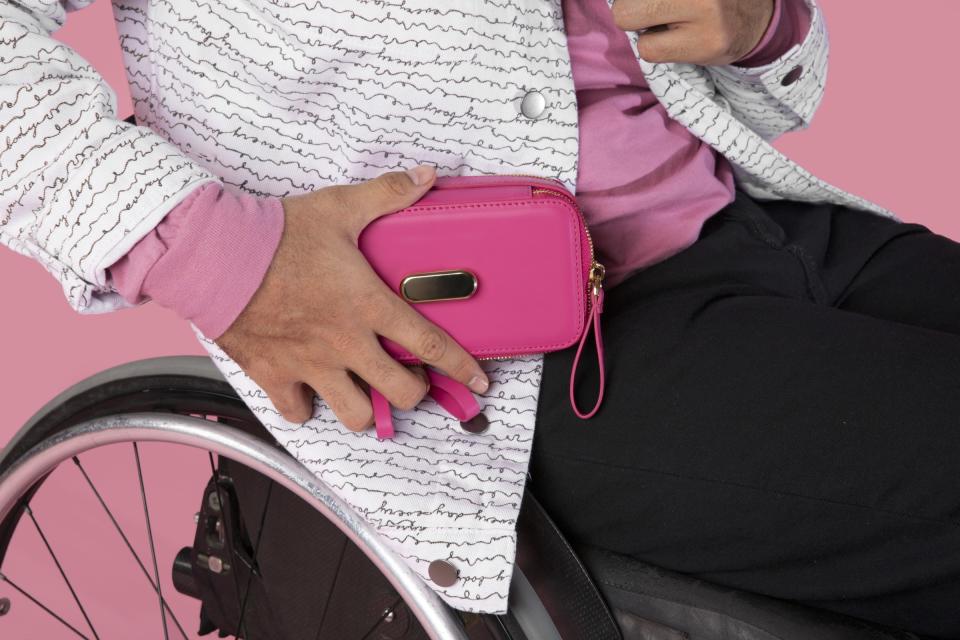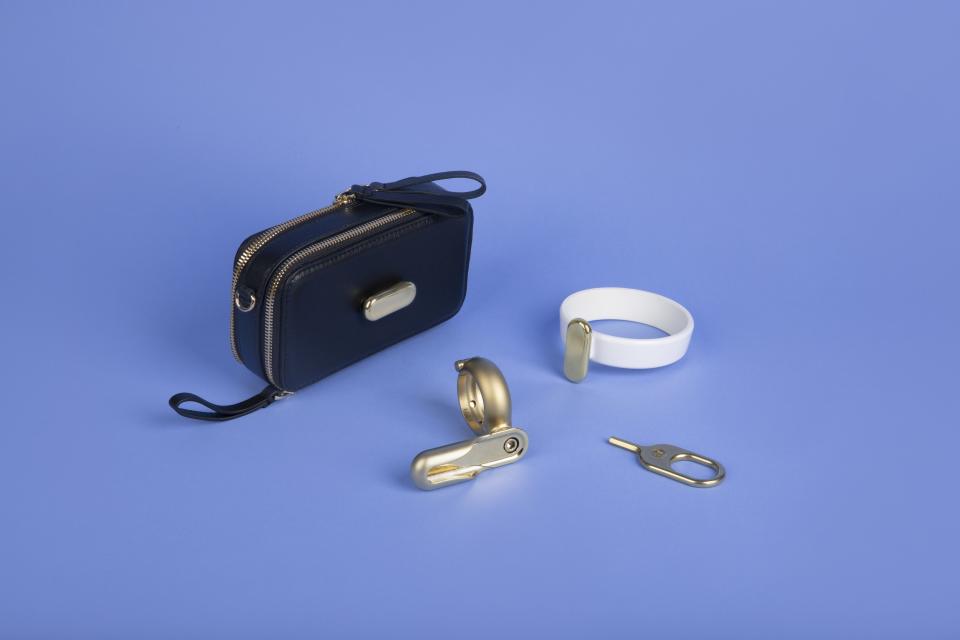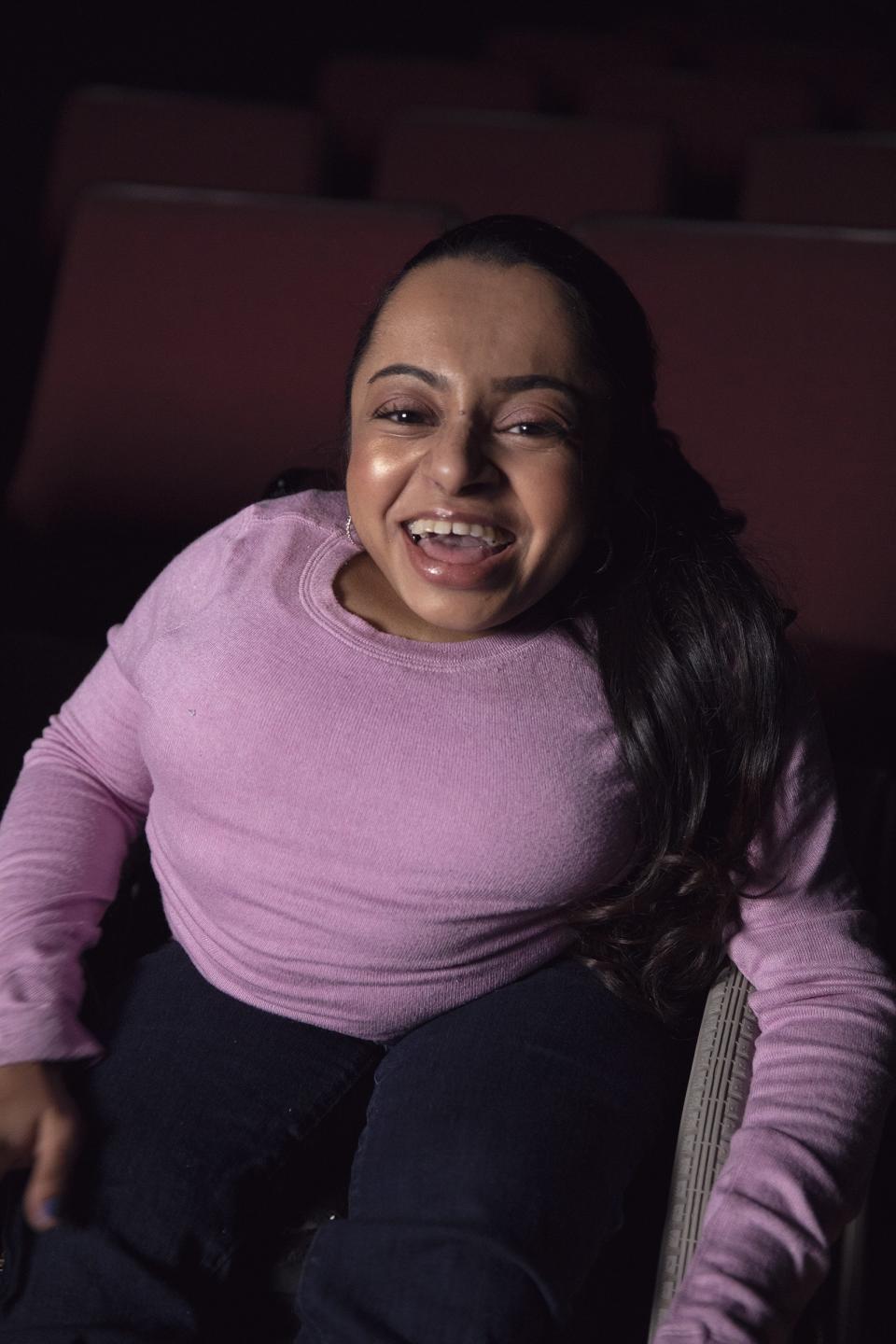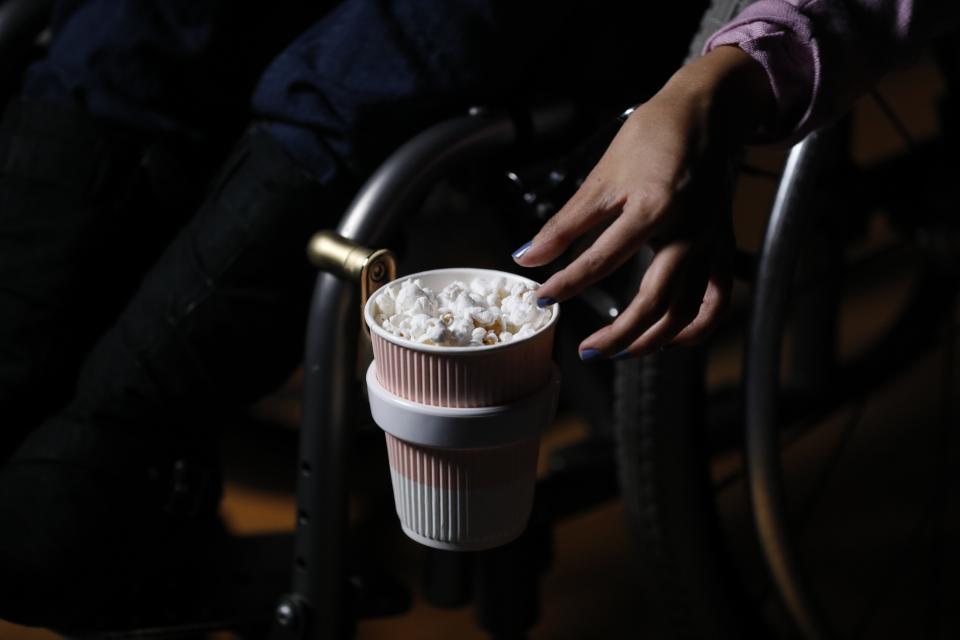FFORA Is a New Line of Functional and Fashionable Accessories for Wheelchair Users
A conversation with a younger family member living with cerebral palsy sparked something in Lucy Jones, a Parsons graduate, now 27. “I realized I had never asked him if he had any difficulty with clothing, or getting dressed, or accessibility in general,” she tells Teen Vogue. She felt she needed to do something, so Jones spent a year listening to and collaborating with the disabled community (including model and former Teen Vogue cover star Jillian Mercado), and is now launching a brand featuring three fashionable and functional accessories that better cater to disabled individuals.
With products integral to the lives of manual-wheelchair users, FFORA aims to be an accessible lifestyle brand designed specifically for the disabled community. “For too long, the disabled community has had to reinvent or hack their belongings or surroundings due to a lack of available products,” says Jones. It is her hope that people will see themselves better reflected in these products, and that her brand will continue the conversation about the need for more thoughtful, functional, and stylish adaptive designs.

Originally from Wales, U.K., Jones came to New York in 2011 to study fashion design at Parsons School of Design. Her first job after graduation was as a “social innovator” with Eileen Fisher, in partnership with the CFDA. She had other stints too, producing commissioned work for the Museum of Art & Design, the Museum of Modern Art, and the Museum at FIT. Now Jones is applying everything she learned in the past decade to launch her debut brand, which she hopes is the start of something much larger.
In honor of FFORA’s launch, Teen Vogue sat down with Jones to hear more about her process for building her company, the functionality of its products, and how collaboration with the disabled community was integral and necessary to do this important work.
Teen Vogue: What inspired you to launch this project? Does the concept relate to your personal life in any way?
Lucy Jones: While I was a student at Parsons, a professor challenged me to “design a solution that could one day change the world,” which led me to start talking with a younger family member who has cerebral palsy, meaning that he has limited mobility along one side of his body. I realized I had never asked him if he had any difficulty with clothing, or getting dressed, or accessibility in general. Very quickly I learned that, in fact, there were quite a few things that were challenging for him, and it completely opened my eyes. This challenged me to better consider the accessibility of my creations and reach out and listen to others’ stories. I spent a year listening to a diverse group of individuals who all had varying needs and desires. Quite often we design things without thinking about all of our customers, and I felt there needed to be a brand that represented design with accessibility at its core, thus, FFORA was born.

TV: What's the mission behind your brand?
LJ: FFORA’s mission is to design a world that’s accessible to all. It’s a huge goal, but we have to start somewhere. We know it will take collaboration, innovation, and patience to get there. For too long, the disability community has had to reinvent or hack their belongings or surroundings due to lack of available products. We believe everyone deserves to see themselves reflected in the products that they use every day, and I hope that FFORA will support the continuation of this conversation.

TV: Can you tell us more about what's in the collection? How do the pieces work?
LJ: At the heart of the product line is our proprietary Attachment System, which is a clamp and open dock that affixes to the lower tubes of more than 170 models of manual wheelchairs. This dock is the building block that holsters an array of additional FFORA accessories, including our cupholder and two crossbody bags.
The bags can dock vertically or be worn on the body horizontally with our crossbody strap. Each accessory has a magnetic pebble-shaped counterpart embedded into the design, which allows it to slide into the dock, and holds it in place. By positioning personal belongings on the tubes of their wheelchairs, our customers have easy access to their essentials; beverages, phone, cash, lipstick, keys, and more, all readily available, within arm’s reach. The bags have two-way zippers with “thumb-pulls,” perfect for those without fine motor skills. The bags also open flat like books for easy organization.
Previously, our customers would sit on their items, have items loose on their lap, or in bags at the backs of their chairs and out of sight. Our products place the essentials within view and simultaneously allow our customers to be as hands free as possible. The collection comes in a variety of colors, inviting people to build their product assortment in the way that best expresses their identity and needs.

TV: What was your process for building this brand? What were some challenges you ran into as an adaptive designer?
LJ: Collaboration and cooperation have also been vital as we build FFORA. We have involved people with disabilities throughout this entire process, and we have now created new jobs specifically for them. Creating products within strict design parameters was also challenging at first, since active, everyday wheelchairs are made-to-measure, like a tailored suit, according to specific bodies and needs. Instead of thinking about arms and leg measurements, we have been thinking about tubes, poles, and wheels, which are all integral to the form and self-expression. Together with the community, we find these challenges incredibly invigorating.

TV: What do you hope people will take away from seeing these products and buying/wearing them?
I hope FFORA can broaden people’s minds and raise the bar in demonstrating how inventive a fashion and lifestyle brand can be. I hope our products spark creativity and motivate others to learn more. Our bags are primarily designed for use with wheelchairs, but they also come with crossbody straps so they can be used by people who do not have a disability. I hope people see FFORA and understand that by designing with disability in mind, everyone will benefit.

TV: Are there any other adaptive designers on your radar right now, or designers you looked up to when creating this collection?
LJ: Swedish designer Louise Linderoth is absolutely incredible. Her work is not only thought-provoking, but as a chair-user herself, she is challenging traditional conventions. The team behind Alleles Design creates beautiful covers for prosthetics, and Canadian-based Izzy Camilleri is fantastic. We’ve looked up to a number of advocates within the fashion industry who are leading the conversation and using their influence to talk about or highlight disability inclusion, including models Bri Scalesse and Jillian Mercado, with whom we have also worked.

TV: What do you feel the fashion industry is getting wrong about consumers with disabilities? How could it better cater to them through products and campaign messaging?
LJ: In the past, brands that have attempted to tackle or address disability issues have traditionally felt inauthentic. Inclusion and representation are very important, but they shouldn’t feel like a required check-box, and the design should further reflect the investment into the community it serves. The first and most important thing is to involve and invite the community into the design discussions, listen to feedback, and incorporate their suggestions.
Originally Appeared on Teen Vogue

